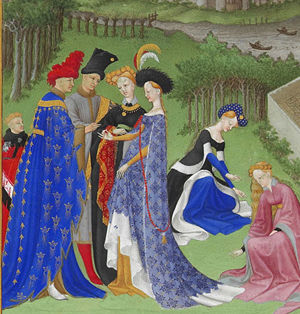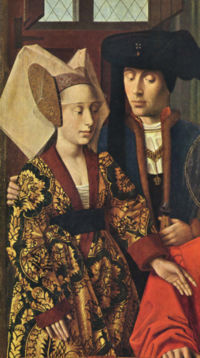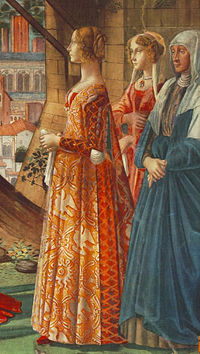Traveling within the World
Linking your favorite traveling artists across the globe


Fashion in 15th century Europe was characterized by a series of extremes and extravagances, from the voluminous gowns called houppelandes with their sweeping floor-length sleeves to the revealing doublets and hose of Renaissance Italy. Hats, hoods, and other headdresses assumed increasing importance, and were swagged, draped, jewelled, and feathered.
As Europe continued to grow more prosperous, the urban middle classes, skilled workers, began to wear more complex clothes that followed, at a distance, the fashions set by the elites. National variations in clothing seem on the whole to have increased over the century.[1]
General trends
Dominance of the Burgundian court
With England and France mired in the Hundred Years War and its aftermath and then the English Wars of the Roses through most of the century, European fashion north of the Alps was dominated by the glittering court of the Duchy of Burgundy, especially under the fashion-conscious power-broker Philip the Good (ruled 1419–1469). Having added Holland and Flanders to their dominion, the Dukes of Burgundy had access to the latest fabrics of Italy and the East and to English wool exports through the great trading cities of Bruges and Antwerp.[2] Purchases of fabrics through Italian merchants like the two cousins Giovanni Arnolfini amounted to a noticeable proportion of all government expenditure.[3] Especially in Florence, where sumptuary laws prevented the citizens from wearing the most luxurious cloths on which the city's fortunes were built, the materials of men's clothing in particular often appear plain in paintings, but contemporaries who understood the difference in grades of cloth very well would have appreciated the beauty and great expense of a very fine grade.[4]
Fabrics and furs
Wool was the most popular fabric for all classes by far, followed by linen and hemp.[5] Wool fabrics were available in a wide range of qualities, from rough undyed cloth to fine, dense broadcloth with a velvety nap; high-value broadcloth was a backbone of the English economy and was exported throughout Europe.[6] Wool fabrics were dyed in rich colours, notably reds, greens, golds, and blues, although the actual blue colour achievable with dyeing with woad (and less frequently indigo) could not match the characteristic rich lapis lazuli pigment blues depicted in contemporary illuminated manuscripts such as the Très Riches Heures du duc de Berry.[5]
Silk-weaving was well-established around the Mediterranean by the beginning of the century, and figured silks, often silk velvets with silver-gilt wefts, are increasingly seen in Italian dress and in the dress of the wealthy throughout Europe. Stately floral designs featuring a pomegranate or artichoke motif had reached Europe from China in the previous century and became a dominant design in the Ottoman silk-producing cities of Istanbul and Bursa, and spread to silk weavers in Florence, Genoa, Venice, Valencia and Seville in this period.[5][7]
Fur was worn, mostly as a lining layer, by those who could afford it. The grey and white squirrel furs of the Middle Ages, vair and miniver, went out of style except at court, first for men and then for women; the new fashionable furs were dark brown sable and marten. Toward the end of the century, wild animal furs such as lynx became popular.[8] Ermine remained the prerogative and hallmark of royalty.
Slashing
Contemporary chroniclers identify the source of the fashion for slashing garments (to reveal a lining or full undergarment beneath) to the actions of Swiss soldiers in the aftermath of the Battle of Grandson in 1476.[9] Supposedly the Swiss plundered the rich fabrics of the Burgundian nobles and used the scraps to patch their tattered clothes. In reality, images appear of sleeves with a single slashed opening as early as mid-century, although the German fashion for "many small all-over slits" may have begun here.[10] Whatever its origin, the fad for multiple slashings spread to German Landsknechts and thence to France, Italy, and England, where it was to remain a potent current in fashionable attire into the mid-seventeenth century.
A second result of the defeat at Grandson was the decline of Burgundy as a fount of culture and fashion. The heiress Mary of Burgundy married Maximilian I, Holy Roman Emperor but died young. In the last decade of the century, Charles VIII of France invaded Italy and was briefly declared King of Naples. As a result, the French nobility were introduced to the fabrics and styles of Italy, which would combine with German influence to dominate fashion in France (and later, England) in the first half of the sixteenth century.[11]
Women's fashion
Gown, kirtle, and chemise

Women's fashions of the fifteenth century consisted of a long gown, usually with sleeves, worn over a kirtle or undergown, with a linen chemise or smock worn next to the skin. The long-waisted silhouette of the previous period was replaced by a high-waisted style with fullness over the belly, often confined by a belt. The wide, shallow scooped neckline was replaced by a V-neck, often cut low enough to reveal the decorated front of the kirtle beneath.
Various styles of overgowns were worn. The cotehardie fitted smoothly from the shoulders to the hips and then flared by means of inserted triangular gores. It featured sleeves tight to the elbow with hanging streamers or tippets. The tight fit was achieved with lacing or buttons. This style faded rapidly from fashion in favor of the houppelande, a full robe with a high collar and wide sleeves that had become fashionable around 1380 and remained so to mid-century.[12] The later houppelande had sleeves that were snug at the wrist, making a full "bag" sleeve. The bag sleeve was sometimes slashed in the front to allow the lower arm to reach through.
Around 1450, the gown of northern Europe developed a low V-neck that showed a glimpse of the square-necked kirtle. The neckline could be filled in with a sheer linen partlet. Wide turn-backs like revers displayed a contrasting lining, frequently of fur or black velvet, and the sleeves might be cuffed to match. Sleeves were very long, covering half of the hand, and often highly decorated with embroidery. Fine sleeves were often transferred from one dress to another.
In Italy, the low scoop-neck of the early decades gave way to a neckline that was high in front with a lower V-neck at the back at mid-century. This was followed by a V-neckline that displayed the kirtle or gamurra (sometimes spelled camorra). Sleeveless overgowns were popular, and the gamurra sleeves displayed were often of rich figured silks. A lighter-weight undergown for summer wear was the cotta. A sideless overgown called the giornea was worn with the gamurra or cotta. Toward the end of the period, sleeves were made in sections or panels and slashed, allowing the full chemise sleeves below to be pulled through in puffs along the arm, at the shoulder, and at the elbow. This was the beginning of the fashion for puffed and slashed sleeves that would last for two centuries.[12][13]
The partlet, a sort of separate yoke to fill in a low neckline, appeared in this period, usually of sheer fabric (linen or possibly silk) with an open V-neckline. Burgundian partlets are usually depicted worn under the gown (but over the kirtle); in Italy the partlet seems to have been worn over the gown and could be pointed or cut straight across at the lower front.
Two uniquely Spanish fashions appear from the 1470s. The verdugada or verdugado was gown with a bell-shaped hoop skirt with visible casings stiffened with reeds, which would become the farthingale. The earliest depictions of this garment come from Catalonia, where it is worn with pieced or slashed sleeves and the second new style, a chemise with trumpet sleeves, open and very wide at the wrist.[1]
The sideless surcoat of the 14th century became fossilized as a ceremonial costume for royalty, usually with an ermine front panel (called a plackard or placket) and a mantle draped from the shoulders; it can be seen in variety of royal portraits and as "shorthand" to identify queens in illuminated manuscripts of the period.
Hairstyles and headdresses
A variety of hats and headdresses were worn in Europe in this century.
The crespine of Northern Europe, originally a thick hairnet or snood, had evolved into a mesh of jeweler's work that confined the hair on the sides of the head by the end of the fourteenth century. Gradually the fullness at the sides of head was pulled up to the temples and became pointed, like horns (à corné).[12]
By mid-century, the hair was pulled back from the forehead, and the crespine, now usually called a caul, sat on the back of the head. Very fashionable women shaved their foreheads and eyebrows.
Any of these styles could be topped by a padded roll, sometimes arranged in a heart-shape, or a veil, or both. Veils were supported by wire frames that exaggerated the shape and were variously draped from the back of the headdress or covered the forehead.
Women also wore the chaperon,[citation needed]} a draped hat based on the hood and liripipe, and a variety of related draped and wrapped turbans.
The most extravagant headdress of Burgundian fashion is the hennin, a cone or truncated-cone shaped cap with a wire frame covered in fabric and topped by a veil. Later hennins feature a turned-back brim, or are worn over a hood with a turned-back brim.[14]
Women of the merchant classes in Northern Europe wore modified versions of courtly hairtyles, with coifs or caps, veils, and wimples of crisp linen (often with visible creases from ironing and folding). A brief fashion added rows of gathered frills to the coif or veil; this style is sometimes known by the German name kruseler.[15]
The general European convention of completely covering married women's hair was not accepted in warmer Italy.[12] Italian women wore their hair very long, wound with ribbons or braided, and twisted up into knots of various shapes with the ends hanging free. The hair was then covered with sheer veils or small caps. Toward the 1480s women wore chin-length sections of hair in loose waves or ripples over the ears (a style that would inspire "vintage" hair fashions in the 1620s and '30s and again in the 1840s and 1850s). Blond hair was considered desirable (by Botticelli for one), and visitors to Venice reported that ladies sat out in the sun on their terraces with their hair spread out around large circular disks worn like hats, attempting to bleach it in the sun. Chemical methods were also used.[16]
Style gallery – Northern Europe 1400s–1440s
- Image of Christine de Pisan in a cotehardie. She wears a wired "horned" headdress with a veil. France, 1410–11.
- Christine de Pisan presents her book to Queen Isabeau, who wears a figured houppelande lined in ermine with a broad collar and a heart-shaped headdress. Her books stress that women should dress appropriately to their station in life, as her own less sumptuous headdress here reflects.[17]
- This woman wears a houppelande of dark blue figured fabric with a narrow belt. Her hair is shaved back from her forehead, and she wears a blunt pointed cap (now over-restored), France or Flanders, c. 1410.[18]
- Modestly-dressed woman wears a linen headdress and a grey gown lined in black fur confined with a belt at the high waist. Her veil is pinned to her cap, and has sharp creases from ironing, Netherlands, 1430.
- Margarete van Eyck wears a horned headdress with a ruffled veil called a kruseler. Her red gown is lined in grey fur, 1439.
- Gown with fur-lined bag sleeves, Bruges, 1443.
- Two women at a baptism (likely godmother and mother) wear heart-shaped headdresses with veils and belted, fur-lined gowns open at the front to display the chemises beneath, Burgundy, 1445–50.
- Isabella of Portugal, Duchess of Burgundy, wears an elaborate embroidered and jeweled headdress with a sheer veil. Her gown is made of an artichoke-patterned red velvet on a gold ground, lined with ermine, and laces at the front opening. She wears a sheer linen partlet and a checkered belt, c. 1445–50[19]
- Margaret of Anjou, Queen consort of Henry VI of England. She is wearing the close-fitting cotehardie with gold buttons and tight gold sleeves. Her red mantel is richly embroidered at the neck and clasped with a brooch.
Tags:
Replies to This Discussion
Events
-
2014 is the Chinese Year of the Horse
February 17, 2026 at 12am to February 5, 2027 at 12am – where & how you choose
Birthdays
Birthdays Tomorrow
Important (read & understand)
Skype: Travelingraggyman
Email and Instant Messenger:
TravelerinBDFSM @ aol/aim; hotmail; identi.ca; live & yahoo
OR
Travelingraggyman @ gmail and icq ***

1AWARD UPDATES & INFORMATION
10,000 votes - Platinum Award
5,000 votes - Gold Award
2,500 votes - Silver Award
1,000 votes - Bronze Award
300 votes - Pewter Award
100 votes - Copper Award
Member of the Associated Posting System {APS}
This allows members on various sites to share information between sites and by providing a by line with the original source it credits the author with the creation.
Legal Disclaimer
***************We here at Traveling within the World are not responsible for anything posted by individual members. While the actions of one member do not reflect the intentions of the entire social network or the Network Creator, we do ask that you use good judgment when posting. If something is considered to be inappropriate it will be removed
Site Meter
This site is strictly an artist operational fan publication, no copyright infringement intended
Patchwork Merchant Mercenaries had its humble beginnings as an idea of a few artisans and craftsmen who enjoy performing with live steel fighting. As well as a patchwork quilt tent canvas. Most had prior military experience hence the name.
Patchwork Merchant Mercenaries.
Vendertainers that brought many things to a show and are know for helping out where ever they can.
As well as being a place where the older hand made items could be found made by them and enjoyed by all.
We expanded over the years to become well known at what we do. Now we represent over 100 artisans and craftsman that are well known in their venues and some just starting out. Some of their works have been premiered in TV, stage and movies on a regular basis.
Specializing in Medieval, Goth , Stage Film, BDFSM and Practitioner.
Patchwork Merchant Mercenaries a Dept of, Ask For IT was started by artists and former military veterans, and sword fighters, representing over 100 artisans, one who made his living traveling from fair to festival vending medieval wares. The majority of his customers are re-enactors, SCAdians and the like, looking to build their kit with period clothing, feast gear, adornments, etc.
Likewise, it is typical for these history-lovers to peruse the tent (aka mobile store front) and, upon finding something that pleases the eye, ask "Is this period?"
A deceitful query!! This is not a yes or no question. One must have a damn good understanding of European history (at least) from the fall of Rome to the mid-1600's to properly answer. Taking into account, also, the culture in which the querent is dressed is vitally important. You see, though it may be well within medieval period, it would be strange to see a Viking wearing a Caftan...or is it?
After a festival's time of answering weighty questions such as these, I'd sleep like a log! Only a mad man could possibly remember the place and time for each piece of kitchen ware, weaponry, cloth, and chain within a span of 1,000 years!! Surely there must be an easier way, a place where he could post all this knowledge...
Traveling Within The World is meant to be such a place. A place for all of these artists to keep in touch and directly interact with their fellow geeks and re-enactment hobbyists, their clientele.
© 2024 Created by Rev. Allen M. Drago ~ Traveler.
Powered by
![]()











